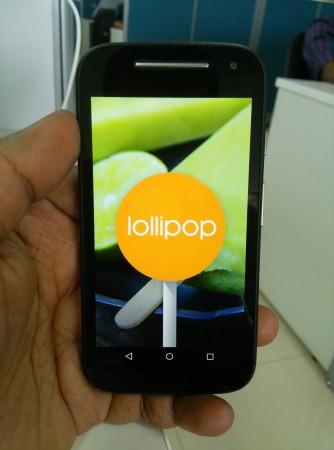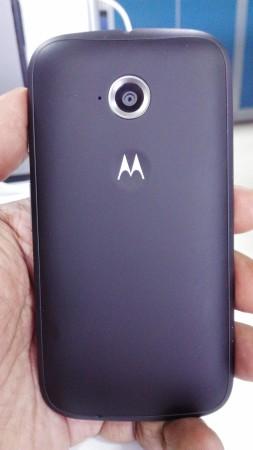
Motorola has released Moto E2 alias Moto E 2md Generation in two variants: The Moto E2 3G and Moto E2 4G. Both the phones offer almost identical software and hardware combination, except the 4G edition comes with a better processor. The 3G edition of Moto E 2nd Generation is already available for purchase through Flipkart, while the 4G edition has just been made available for buying through the same website. While the 3G edition of Moto E 2nd Generation is ₹6,999, the 4G edition is available on sale for ₹7,999.

Built and Design
The Moto E 2nd generation 4G LTE edition looks identical to its 3G edition with a pebble-like design, matte rubberised back, textured edge, and Gorilla Glass 3 Front. The textured edge is removable and made of plastic. Named as bands, users can buy few to make the device look different.
The groovy edge also hides the micro SIM and Micro SD card slot. When attached, the rim looks firm like Moto Turbo's rear cover, but once opened it looks flimsy and a tad plastic-like too.
Beyond this, we found the Moto E2 4G looks and feels quite impressive. With 140x67x12.3mm dimension and 145g of weight the device feels a bit small but comfortable enough in hand.
[Read More: Moto E 2nd Generation 3G Edition Review]
Display
The screen specification is one of the most important features for affordable smartphones. While most of the similar or below priced competitor smartphones offer 720p display, 4.5-inch qHD display with 960x540 pixels resolution is a poor choice.
However, Motorola tried to compensate the resolution with its feature-like ambient display. But we found the screen a little dim and less sharp. Colour balance levels were good, and text and icons appear nicely on the screen. The display remains readable under direct sunlight and also offers decent viewing angles.
Major Difference
Running on same Android 5.0.2 Lollipop, the Moto E2 4G edition offers major difference in the performance segment. Comparing to the 3G editions SnapDragon 200 SoC, the 4G edition comes powered by a Snapdragon 410 SoC, which is seen in most budget and mid-budget smartphones. For example, Redmi 2, Lenovo A6000, and Huawei Honor 4X all packs the same SoC.
Aptly backed by a 1GB RAM memory, the Moto E2 4G edition scored 22,142 on AnTuTu and 342 on Single-Core and 1,134 multi-core on GeekBench. The scores are not only better than the Moto E2 3G edition, but also beats Redmi 2's 20,736 and A6000's 19830 in AnTuTu. However, in GeekBench both the Redmi 2 and A6000 performed a tad better than the Moto E2 4G edition.
Talking about the real life usage, we would like to mention, this is one of the most affordable smartphones for everyday purpose. Applications opened quickly and surfing between pages were chug free.
Camera, Battery Life and Storage
As we mentioned earlier, the Moto E end Generation 4G edition is identical to its 3G edition, except the processor. It retains the same camera, features similar interface, runs on same OS and offers similar RAM and internal storage. Read our 3G edition review to know more on its performance on these segments.
Competitor
At ₹7,999, the Moto E 2nd Generation will compete with few of the most popular smartphones in the budget genre. For example, Lenovo has just released A7000 in the same price range that also runs on Lollipop and packs outstanding specification.
Lenovo has also launched its most popular A6000's successor A6000 Plus with same processor but 2GB RAM and 16GB ROM. Xiaomi's Redmi 2 and Lenovo's A6000 also packs the same processor with better camera and costs ₹1,000 less than Moto E 4G edition. However, both the smartphones run on the dated Android Kitkat 4.4.
Micromax has also just tipped to launch its budget smartphone Canvas Spark in similar price range.
However, the Moto E2 4G offers great battery life and the only smartphone run on Android 5.0.2 Lollipop out of the box. Of course, Moto E2 4G offers decent usability but for the price there are too many interesting options available.














